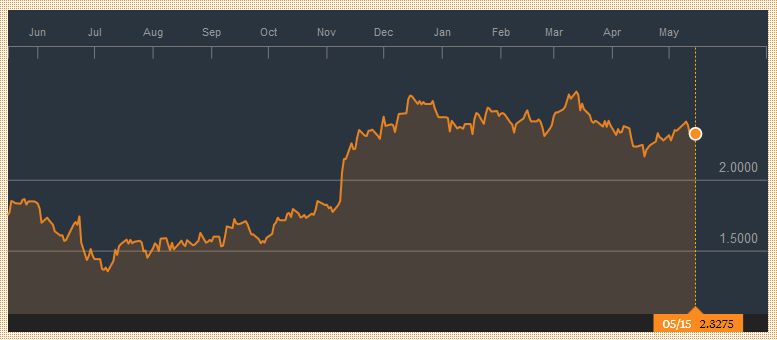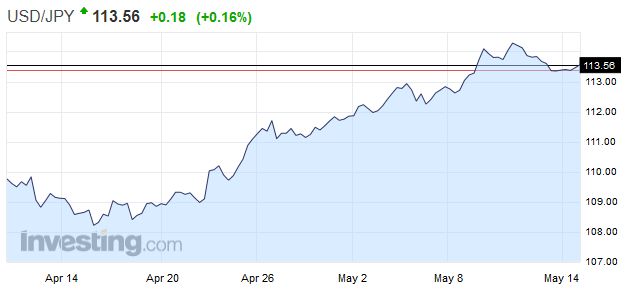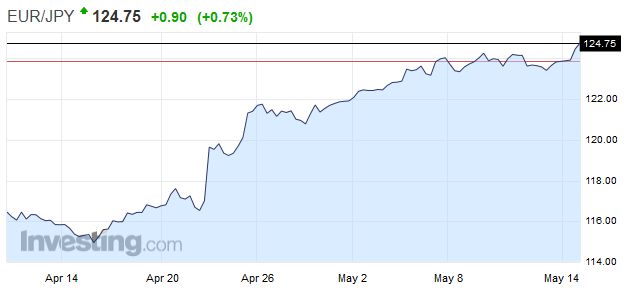Summary:
Yen was the strongest currency in the world from mid-March to mid-April.
Yen has been the weakest currency over the past month.
US rates have risen relative to Japan.
Japan has shifted away from QE and toward targeting interest rate.
USD/JPYFrom March 10 through April 11, the Japanese yen was the strongest currency in the world. It appreciated 4.7% against the dollar. Among the majors, sterling came in second place with a 2.7% gain. Among emerging market currencies, the yen edged past the Mexican peso’s 4.4% rise. That was then. This is now. Since April 11, the yen is the world’s weakest currency. It lost 3.6% against the greenback. The Canadian dollar is a close second with a 3.3% decline. In the emerging market space, the Chilean peso has been the worst performer, nursing a 2.7% loss. |
USD/JPY - US Dollar Japanese Yen, Monthly(see more posts on USD/JPY, ) |
EUR/JPYThe BOJ has shifted from targeting a specific expansion of its balance sheet to targeting interest rates. In addition to its negative 10 bp deposit rate, the BOJ is targeting 10-year yields within a ten basis point range around zero. To maintain this range, the BOJ does not need to buy JPY80 trillion of assets. BOJ Governor Kuroda acknowledged this before, but this week he provided specifics, suggesting that its balance sheet is rising at a pace closer to JPY60 trillion. |
EUR/JPY - Euro Japanese Yen, Monthly(see more posts on EUR/JPY, ) |
US TreasuriesThe reversal of the yen lines up well with the sell-off in US Treasuries and the widening of the US interest rate premium over Japan. The US 10-year yield bottomed near 2.16% on April 18. The dollar bottomed against the yen the previous day just above JPY108. The US premium over Japan on 10-year paper bottomed on April 18 around 2.16%. The US 10-year yield has risen to 2.42% today before pulling back a bit, despite the larger than expected rise in PPI and the continued recovery in oil prices after staging an upside reversal at the end of last week. The US premium over Japan rose to nearly a two-month high yesterday above 2.37%. |
Yield US Treasuries 10 years, May 2016 - May 2017(see more posts on U.S. Treasuries, ) Source: Bloomberg.com - Click to enlarge |
It seems that the markets move between two main explanatory and descriptive models of foreign exchange. The first relates to external imbalances. Currencies move to bring trade balances into equilibrium. This is the traditional approach. Countries with large surpluses should have appreciating currencies and countries with large deficits should have depreciating currencies.
This is similar to Purchasing Power Parity. Currencies move to equalize the price of a basket of traded goods. It was on such ideas that many economists claimed that if the US would implement a border adjustment tax, that the dollar would “automatically” rise to offset it. Even though highly regarded economists, like Martin Feldstein, argued along such lines, it seemed naive to us.
The second explanatory and descriptive model is based on interest rates. Foreign exchange is the price of money and so are interest rates. The two elements of the price of money seem related even if not in a linear fashion. It is partly derived from interest rate covered parity, which is the idea that currencies ought to move to equalize interest rates. We have adopted a softer version of it in our divergence narrative.
World trade in goods and services was about $25 trillion last year. The turnover in the foreign exchange market is a little more than $25 trillion a week. In the major currencies, capital flows outstrip trade flows by a large multiple. The fragmentation of trade, the extended supply chains, transfer pricing, competition for market share rather than profit margins may help explain why trade does not appear as sensitive to currency fluctuations as may have been the case in the past.
Moreover, as the net international investment positions have grown, trade flows do not always drive the current account balance. Japan reported March current account figures earlier today. It reported a JPY2.9 trillion surplus, one of the largest over the past two decades. However, the goods surplus was about JPY866 bln. The key driver was the surplus on investment income. That stood at JPY2.2 trillion.
In Japan’s case, the weaker yen has not boosted exports very much. Rather a weak yen flatters the current account not by lifting exports, but by boosting the yen value of the coupons, dividends, and profits earned abroad.
The current thinking in the market is that the Federal Reserve will hike rates in June (95% chance according to Bloomberg and 83% chance according to the CME). The market is not convinced that a third hike this year will be delivered. Bloomberg calculates the odds at about 45% chance that the Fed funds target at the end of the year will be 1.25%-1.50%, while the CME puts the probability closer to 40%. The market expects the ECB to alter its forward guidance formally in June and announce tapering intentions in September.
The US reports April retail sales and consumer prices tomorrow. Both are expected to have improved from soft March readings. If our analysis is correct, and the key to dollar-yen is the US 10-year yield than tomorrow’s data could be important. However, give the recent price action, it would seem to require an upside surprise of the data to extend the rise in US yields and the dollar against the yen. Initial support for the dollar is seen in the JPY113.00-JPY113.20 area, and a break could spur a move back to JPY112.00.
Full story here Are you the author? Previous post See more for Next postTags: #USD,$JPY,$TLT,EUR/JPY,newslettersent,U.S. Treasuries,USD-CNY,usd-jpy










































